
The striated antbird is a species of bird in subfamily Thamnophilinae of family Thamnophilidae, the "typical antbirds". It is found in Bolivia, Brazil, Colombia, Ecuador, and Peru.

Frederickena is a genus of passerine birds in the antbird family, Thamnophilidae. These are among the largest antbirds, and are native to the Guianas and Amazon Rainforest in South America. They are infrequently seen and generally found at very low densities.
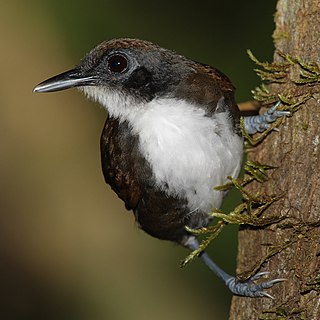
Gymnopithys is a genus of passerine birds in the antbird family, Thamnophilidae.
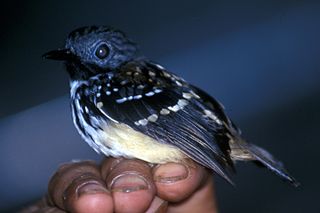
Hylophylax is a genus of bird in the family Thamnophilidae.

The common scale-backed antbird is a species of passerine bird in subfamily Thamnophilinae of family Thamnophilidae, the "typical antbirds". It is found in Bolivia, Brazil, Colombia, Ecuador, French Guiana, Guyana, Peru, Suriname, and Venezuela.

Hypocnemis is a genus of passerine birds in the family Thamnophilidae. They are resident breeders in tropical Central and South America.
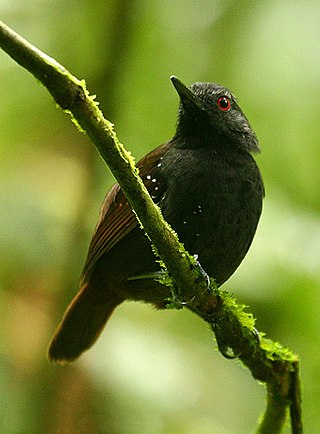
The dull-mantled antbird is a perching bird species in subfamily Thamnophilinae of family Thamnophilidae, the "typical antbirds". It is found in Colombia, Costa Rica, and Panama.
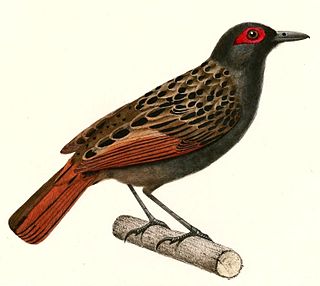
Phlegopsis is a genus of insectivorous passerine birds in the antbird family, Thamnophilidae. They are known as "bare-eyes", which is a reference to a colourful bare patch of skin around their eyes. They are restricted to humid forest in the Amazon of South America. They are among the largest ant-followers in the family and are only rarely seen away from ant swarms.
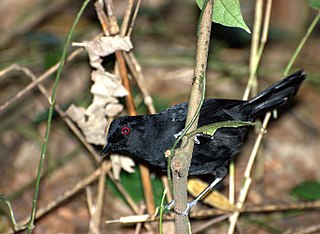
The fire-eyes, Pyriglena, are a genus of birds in the antbird family Thamnophilidae.The genus contains 5 species, all found in South America. The fire-eyes are 16–18 cm in length, weigh 25-36 g and have characteristic red eyes that give them their name. They have sexually dimorphic plumage, with the females possessing brown to buff coloured bodies with black tails, and the males being black with small patches of white on the back or wings. The fire-eyes eat a variety of insects, and will regularly follow army ants in order to catch prey flushed by them. Two of the fire-eyes are widespread and safe, but one species, the fringe-backed fire-eye, is threatened with extinction.

The band-tailed antshrike is a species of bird in subfamily Thamnophilinae of family Thamnophilidae, the "typical antbirds". It is found in Brazil, French Guiana, Guyana, and Suriname.
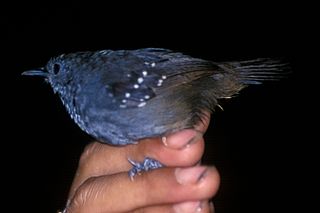
Myrmelastes is a genus of passerine birds in the family Thamnophilidae. Most of these species were previously placed in the genus Schistocichla. The genus formerly included only three species, but several taxa previously considered subspecies of the spot-winged antbird have been elevated to species status.

The Xingu scale-backed antbird is a species of bird in subfamily Thamnophilinae of family Thamnophilidae, the "typical antbirds". It is endemic to Brazil.
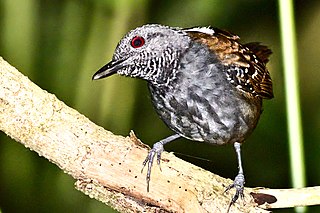
The Magdalena antbird is a Near Threatened species of bird in subfamily Thamnophilinae of family Thamnophilidae, the "typical antbirds". It is found in Colombia and Venezuela.

Isleria is a genus of insectivorous birds in the antbird family, Thamnophilidae.
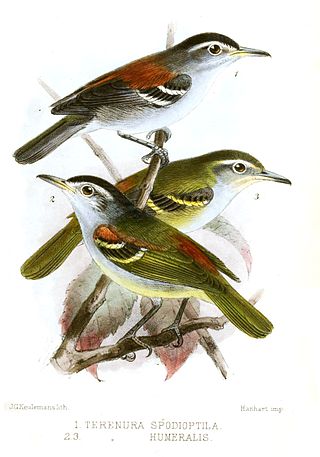
Euchrepomis is a genus of insectivorous passerine birds in the antbird family, Thamnophilidae.
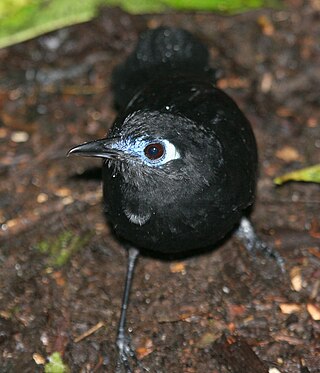
Zeledon's antbird is a species of bird in subfamily Thamnophilinae of family Thamnophilidae, the "typical antbirds". It is found in Colombia, Costa Rica, Ecuador, Nicaragua, and Panama.

The riparian antbird is a species of passerine bird in subfamily Thamnophilinae of family Thamnophilidae, the "typical antbirds". It is found in Bolivia, Brazil, Colombia, Ecuador, and Peru.

Sipia is a genus of passerine birds in the family Thamnophilidae.

Edwin O'Neill Willis was an American ornithologist who studied the birds of Central and South America.



















